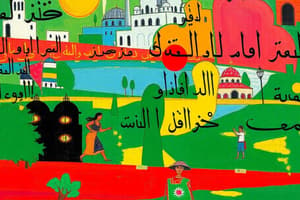Podcast
Questions and Answers
What is the reason for preferring the term 'Indian people' when referring to Indigenous groups?
What is the reason for preferring the term 'Indian people' when referring to Indigenous groups?
- It is a more traditional term.
- It stylistically avoids confusion. (correct)
- It is considered more respectful.
- It is less commonly used.
The term 'Sioux' originally comes from a word meaning 'friends' in Algonquian.
The term 'Sioux' originally comes from a word meaning 'friends' in Algonquian.
False (B)
What do the terms 'Anishinaabeg' and 'Anishinaabe' mean?
What do the terms 'Anishinaabeg' and 'Anishinaabe' mean?
original people
The names used to designate many Indian tribes, such as Iroquois and Huron, often have __________ connotations.
The names used to designate many Indian tribes, such as Iroquois and Huron, often have __________ connotations.
Match the following terms with their meanings:
Match the following terms with their meanings:
What was the shape of the ceremonial mound at Poverty Point?
What was the shape of the ceremonial mound at Poverty Point?
Poverty Point was established as the largest plantation in the region around 1500 B.C.
Poverty Point was established as the largest plantation in the region around 1500 B.C.
What was the primary means of transportation for heavy goods used by the Poverty Point people?
What was the primary means of transportation for heavy goods used by the Poverty Point people?
The earthworks at Poverty Point contained nearly ______ cubic yards of dirt.
The earthworks at Poverty Point contained nearly ______ cubic yards of dirt.
Match the following materials with their sources:
Match the following materials with their sources:
Which crop is indicated as significant in southeastern Indian culture?
Which crop is indicated as significant in southeastern Indian culture?
The Adena culture built mounds to honor living individuals.
The Adena culture built mounds to honor living individuals.
Who was the first Englishman to paint Indian people in North America?
Who was the first Englishman to paint Indian people in North America?
Who brought forth the white corn?
Who brought forth the white corn?
The women initially enjoyed being alone after the men left the riverbank.
The women initially enjoyed being alone after the men left the riverbank.
What were the four colors of corn dropped by the Turkey?
What were the four colors of corn dropped by the Turkey?
The Big Snake brought forth the seeds of pumpkin, watermelon, __________, and muskmelon.
The Big Snake brought forth the seeds of pumpkin, watermelon, __________, and muskmelon.
What did First Woman tell the women to use for their needs?
What did First Woman tell the women to use for their needs?
Match the characters with their contributions:
Match the characters with their contributions:
The harvest was poor after the men crossed the river.
The harvest was poor after the men crossed the river.
What happened to some women when they tried to join the men across the river?
What happened to some women when they tried to join the men across the river?
What subsistence strategy did the people in the Great Basin primarily use for their diet?
What subsistence strategy did the people in the Great Basin primarily use for their diet?
The horse-and-buffalo culture of the Plains Indians existed before contact with Europeans.
The horse-and-buffalo culture of the Plains Indians existed before contact with Europeans.
What item was traded in the Great Basin from southern Idaho?
What item was traded in the Great Basin from southern Idaho?
The sedentary communities in the Great Basin relied on a staple diet of ___.
The sedentary communities in the Great Basin relied on a staple diet of ___.
During which period did horticultural communities appear in the Great Basin?
During which period did horticultural communities appear in the Great Basin?
The people known as ___ developed increasingly lethal projectiles like Clovis points.
The people known as ___ developed increasingly lethal projectiles like Clovis points.
Match the following cultures with their primary activities:
Match the following cultures with their primary activities:
What method did Paleo-Indians develop for hunting large game?
What method did Paleo-Indians develop for hunting large game?
What was First Man known as in the First World?
What was First Man known as in the First World?
First Woman stood in the East and symbolized Life.
First Woman stood in the East and symbolized Life.
What is the name of the first seed corn?
What is the name of the first seed corn?
The creatures of the First World were thought of as the ______.
The creatures of the First World were thought of as the ______.
Which element did First Man burn for a fire?
Which element did First Man burn for a fire?
Match the names given to the First World with their meanings:
Match the names given to the First World with their meanings:
The First World had more than one tree.
The First World had more than one tree.
What were the primary colors of the clouds where First Man and First Woman were formed?
What were the primary colors of the clouds where First Man and First Woman were formed?
Flashcards are hidden until you start studying
Study Notes
Terminology
- Indian and Native American serve as collective terms; often used interchangeably.
- Preference for "Indian people" as it reflects self-identification and avoids confusion with historical names.
- Many historical tribal names, such as Iroquois, Huron, and Sioux, are derived from enemy groups and can carry negative implications.
- Sioux originates from a French corruption of an Algonquian term meaning "snakes."
Cultural Identification
- Anishinaabeg refers to the group, while Anishinaabe describes the individuals, meaning "original people."
- Pueblos refers specifically to Indian groups along the Rio Grande, while pueblos (lowercase) is for inhabited towns.
Subsistence and Adaptation
- Sedentary communities along Pyramid Lake and Walker River relied on fish, game, and gathered plants for sustenance.
- Hunting and gathering strategies persisted for ten thousand years across various regions.
- Trade networks flourished, bringing goods like shells from the Pacific coast and obsidian from Idaho, dating back approximately seven thousand years.
Fremont Culture
- Flourished between A.D. 400 and 1300 in certain regions, developing corn agriculture and a sedentary lifestyle.
- Known as "Fremont Culture," lasted approximately nine hundred years within Great Basin historical context.
Paleo-Indians and Early Hunting Practices
- Between 12,000 and 8,000 B.C., Paleo-Indians hunted large game (e.g., mammoths, bison) with stone tools.
- Clovis points marked advancements in hunting technology, allowing for effective game hunting.
- Developments in hunting methods included buffalo drives and corrals.
Poverty Point
- An ancient town in Louisiana with elaborate earthworks, accommodating two to five thousand people around 1500 B.C.
- Earthworks required around 5 million man-hours of labor using stone tools and woven baskets.
- Acted as a commercial hub, with extensive trade reaching as far as Florida and Missouri.
Agricultural Myths and Practices
- First Man and First Woman from Navajo creation myths symbolize the duality of existence (life and death).
- Corn, as a vital crop, plays a prominent role in Native culture, particularly in creation narratives.
- Agricultural advancements included planting seeds from various plants like pumpkins and melons, resulting in a rich harvest.
Women's Roles in Agriculture
- Women initially faced challenges in meeting their needs, leading to various adaptations.
- Conflicts arose between genders regarding work and sustenance, illustrating early societal structures and roles.
- The mythology emphasizes the importance of cooperation and understanding between genders for agricultural success.
Studying That Suits You
Use AI to generate personalized quizzes and flashcards to suit your learning preferences.




